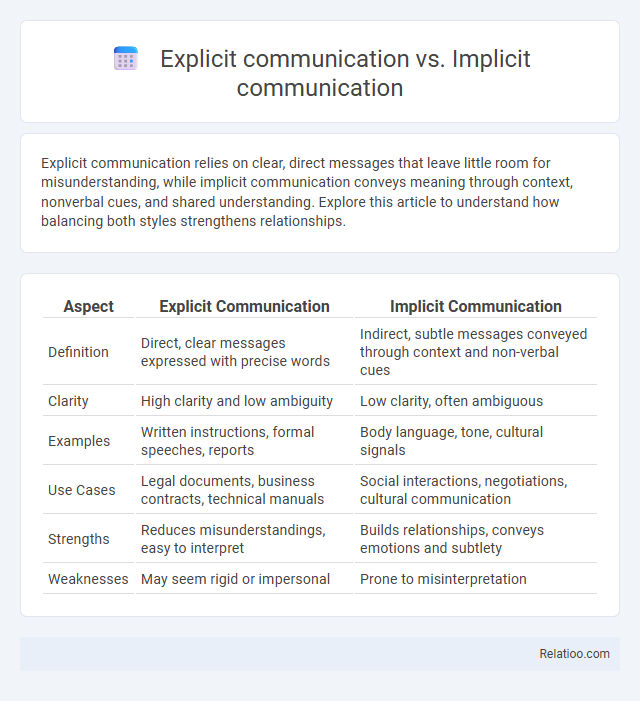Explicit communication relies on clear, direct messages that leave little room for misunderstanding, while implicit communication conveys meaning through context, nonverbal cues, and shared understanding. Explore this article to understand how balancing both styles strengthens relationships.
Table of Comparison
| Aspect | Explicit Communication | Implicit Communication |
|---|---|---|
| Definition | Direct, clear messages expressed with precise words | Indirect, subtle messages conveyed through context and non-verbal cues |
| Clarity | High clarity and low ambiguity | Low clarity, often ambiguous |
| Examples | Written instructions, formal speeches, reports | Body language, tone, cultural signals |
| Use Cases | Legal documents, business contracts, technical manuals | Social interactions, negotiations, cultural communication |
| Strengths | Reduces misunderstandings, easy to interpret | Builds relationships, conveys emotions and subtlety |
| Weaknesses | May seem rigid or impersonal | Prone to misinterpretation |
Introduction to Explicit and Implicit Communication
Explicit communication involves directly stating information, expectations, or instructions, ensuring clarity and reducing misunderstandings in professional or personal interactions. Implicit communication relies on context, non-verbal cues, and shared knowledge to convey messages without overt expression, often requiring interpretation skills in cross-cultural or nuanced conversations. Minimization refers to downplaying issues or emotions, which can hinder effective communication by obscuring the true message or intent.
Defining Explicit Communication
Explicit communication involves clearly and directly conveying your message using precise language to avoid ambiguity and ensure understanding. Unlike implicit communication, which relies on context and nonverbal cues, explicit communication prioritizes clear verbal or written expressions, making expectations, needs, and instructions unmistakable. Minimization reduces the importance or intensity of information, contrasting with explicit communication's goal of full clarity and transparency.
Understanding Implicit Communication
Implicit communication conveys messages through non-verbal cues, tone, and context, often requiring shared knowledge and cultural awareness for accurate interpretation. Unlike explicit communication, which relies on clear and direct language, implicit communication depends on subtle hints and assumed meanings, making it essential to recognize underlying intentions and emotions. Mastering the understanding of implicit communication enhances interpersonal relationships by bridging gaps that explicit words alone cannot address.
Key Differences Between Explicit and Implicit Communication
Explicit communication involves clear, direct expressions where messages are stated openly and unambiguously, making expectations and intentions easy to understand. Implicit communication relies on context, nonverbal cues, and shared understanding to convey meaning indirectly, often requiring interpretation by the receiver. Minimization refers to downplaying or reducing the perceived importance of information, which can affect both explicit and implicit communication by altering the clarity or emphasis of messages.
Cultural Influences on Communication Styles
Explicit communication relies on clear, direct language to convey messages, often preferred in low-context cultures such as the United States or Germany, where clarity and precision are valued. Implicit communication depends heavily on nonverbal cues and shared cultural understanding, common in high-context cultures like Japan or Saudi Arabia, where meaning is often inferred rather than stated outright. Minimization involves downplaying or softening messages to maintain harmony and avoid conflict, which Your awareness of these cultural communication styles helps navigate interpersonal and professional interactions more effectively.
Advantages of Explicit Communication
Explicit communication offers clear and direct messaging, reducing misunderstandings and enhancing efficiency in professional and personal interactions. Your intentions and expectations are conveyed unambiguously, facilitating faster decision-making and stronger accountability. This approach supports transparency, ensuring all parties have a shared understanding that minimizes errors and conflicts.
Benefits of Implicit Communication
Implicit communication leverages nonverbal cues and context to convey messages efficiently, reducing the need for lengthy explanations and fostering a deeper emotional connection. This subtle exchange enhances understanding in relationships by allowing you to interpret intentions and feelings beyond spoken words. The benefits include increased empathy, smoother social interactions, and the ability to navigate sensitive topics with discretion.
Challenges and Misunderstandings
Explicit communication clearly conveys your message through direct language but can sometimes be perceived as blunt or harsh, leading to misunderstandings in sensitive contexts. Implicit communication relies on context, tone, and nonverbal cues, which may cause confusion or misinterpretation if the receiver lacks shared background knowledge. Minimization downplays issues or emotions, creating challenges as important concerns might be ignored or invalidated, ultimately hampering effective problem resolution.
Contexts Where Each Style is Most Effective
Explicit communication is most effective in formal settings such as legal contracts, technical instruction manuals, and safety protocols where clarity and precision are critical to avoid misunderstandings. Implicit communication thrives in cultural, familial, or social contexts where shared backgrounds and nonverbal cues provide deeper meaning without direct statements. Minimization is useful in conflict resolution and emotional discussions by reducing tension through understatement, often applied in therapeutic or diplomatic environments to maintain harmony.
Strategies for Navigating Both Communication Styles
Explicit communication relies on clear, direct language to ensure your message is understood without ambiguity, while implicit communication depends on context, tone, and nonverbal cues to convey meaning subtly. Balancing these styles involves developing strong situational awareness and reading between the lines when interacting with diverse audiences. Minimization strategies, such as simplifying language or focusing on core messages, help bridge gaps by reducing potential misunderstandings in both explicit and implicit exchanges.

Infographic: Explicit communication vs Implicit communication
 relatioo.com
relatioo.com